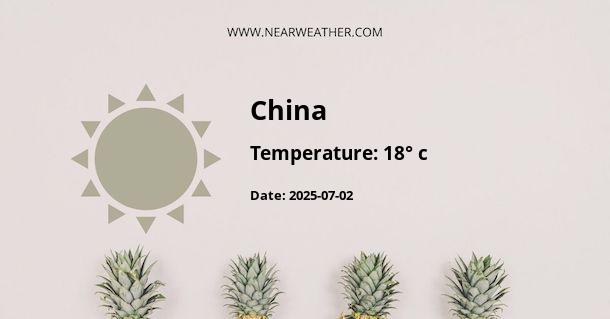Climate and Weather in the People's Republic of China
The People's Republic of China, commonly known as China, is a vast country located in East Asia. It is known for its rich history, diverse culture, and stunning landscapes. As a result of its size and varied geographical features, China experiences a wide range of climates and weather conditions throughout the year. In this article, we will explore the different climate zones in China and provide an overview of the weather patterns you can expect in various regions.
1. Northern China
Northern China generally has a temperate continental climate, characterized by cold and dry winters, and hot and humid summers. The region experiences significant temperature variations between seasons. In winter, temperatures can drop below freezing, especially in the northernmost parts such as Inner Mongolia and Heilongjiang. The summer months, on the other hand, can be scorching hot, with temperatures often exceeding 30°C (86°F). Spring and autumn are relatively short but pleasant seasons.
Precipitation in Northern China is unevenly distributed throughout the year. The majority of rainfall occurs during the summer months, with July and August being the wettest months. Snowfall is common during the winter months, particularly in the northern regions.
Here is a table summarizing the average annual temperature and precipitation in selected cities in Northern China:
| City | Average Annual Temperature (°C) | Average Annual Precipitation (mm) |
|---|---|---|
| Beijing | 12.2 | 570 |
| Tianjin | 12.6 | 550 |
| Harbin | 4.8 | 583 |
2. Eastern China
Eastern China, including the areas along the eastern coast and the Yangtze River basin, has a humid subtropical climate. The region is known for its hot and humid summers, mild and pleasant winters, and ample rainfall throughout the year. The coastal areas are also prone to typhoons during the summer and early autumn months.
Shanghai, one of the major cities in Eastern China, experiences four distinct seasons. Summers in Shanghai can be sweltering, with temperatures often exceeding 35°C (95°F) and high humidity levels. Winters are relatively mild, with average temperatures hovering around 5-8°C (41-46.4°F). Spring and autumn are pleasant with mild temperatures and occasional rainfall.
Here is a table summarizing the average annual temperature and precipitation in selected cities in Eastern China:
| City | Average Annual Temperature (°C) | Average Annual Precipitation (mm) |
|---|---|---|
| Shanghai | 17.8 | 1,100 |
| Nanjing | 16.2 | 1,051 |
| Hangzhou | 17.8 | 1,375 |
3. Southern China
Southern China, including regions such as Guangdong, Guangxi, and Hainan Island, has a humid subtropical to tropical monsoon climate. The region experiences high humidity, abundant rainfall, and relatively mild winters. Summers in Southern China can be hot and rainy, with temperatures often reaching 30-35°C (86-95°F) and frequent afternoon thunderstorms.
Guangzhou, one of the major cities in Southern China, has a year-round mild climate. Winters are short and mild, with temperatures rarely dropping below 10°C (50°F). Summers are long, hot, and humid, with average temperatures around 28-32°C (82-90°F).
Here is a table summarizing the average annual temperature and precipitation in selected cities in Southern China:
| City | Average Annual Temperature (°C) | Average Annual Precipitation (mm) |
|---|---|---|
| Guangzhou | 22.7 | 1,700 |
| Hong Kong | 23.2 | 2,214 |
| Hainan Island (Haikou) | 24.6 | 1,615 |
4. Western China
Western China, encompassing areas such as Tibet, Xinjiang, and Sichuan, has diverse climate patterns due to its varied topography. The region experiences a combination of high-altitude alpine climates, desert climates, and highland steppe climates.
Areas like Lhasa in Tibet have a cold semi-arid climate, with bitterly cold winters and mild summers. The altitude also plays a significant role in the climate, with lower temperatures at higher elevations.
Urumqi, the capital of Xinjiang province, has a continental arid climate. Winters are extremely cold, with temperatures dropping below -20°C (-4°F). Summers are short and hot, with temperatures often exceeding 30°C (86°F).
Here is a table summarizing the average annual temperature and precipitation in selected cities in Western China:
| City | Average Annual Temperature (°C) | Average Annual Precipitation (mm) |
|---|---|---|
| Lhasa | 7.5 | 500 |
| Urumqi | 7.7 | 244 |
| Chengdu | 16.1 | 1,000 |
Conclusion
China's vast size and diverse topography result in a wide range of climates and weather patterns throughout the country. From the cold winters of Northern China to the hot and humid summers of Southern China, each region has its own unique climate characteristics. It is important to consider these variations when planning a trip or living in different parts of China. Whether you are seeking a winter wonderland or a tropical getaway, China has something to offer for everyone.
A - China's Latitude is 35.000000 & Longitude is 105.000000.
A - Weather in China is 6° today.
A - Climate Conditions in China shows overcast clouds today.
A - Humidity in China is 93% today.
A - Wind speed in China is 12.2 km/h, flowing at 117° wind direction. today.
